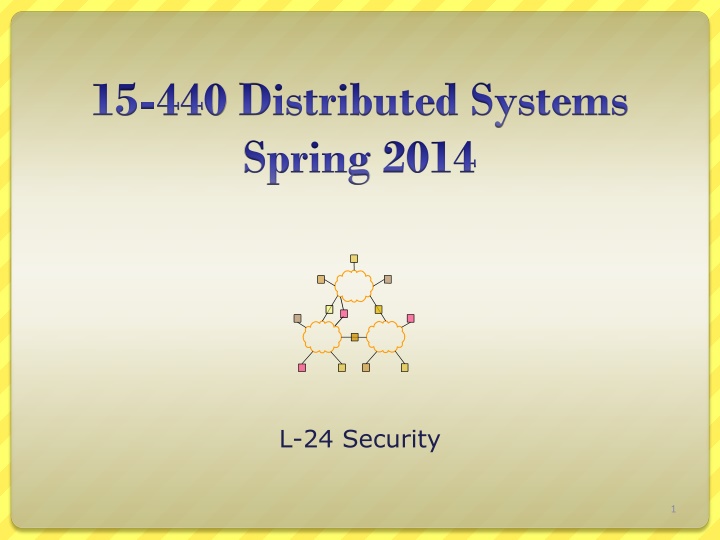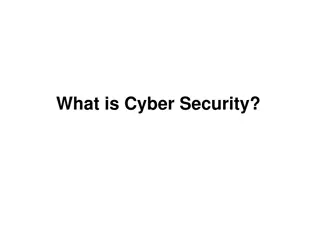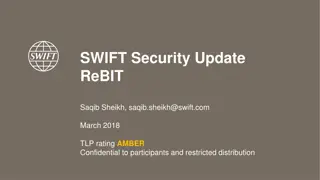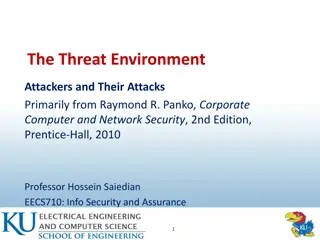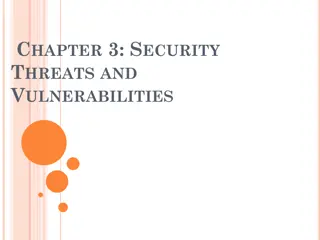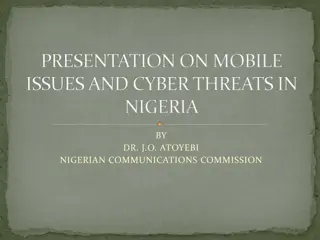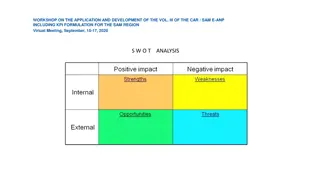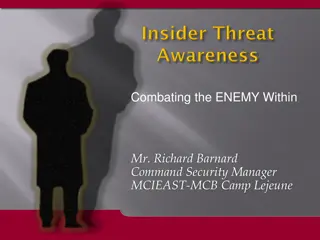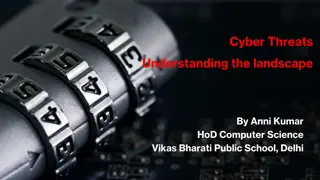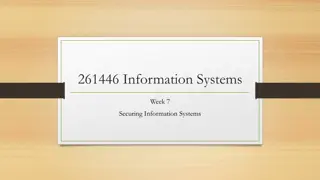Internet Security Overview: Weaknesses, Threats, and Solutions
Today's lecture delves into the vulnerabilities of internet security, from denial-of-service attacks to phishing and data interception. Learn about the importance of secure channels, key distribution, and the essential components for secure communication. Explore the design decisions that shaped the internet as we know it today, highlighting the risks posed by an interconnected world and the need for robust security measures.
Uploaded on Mar 17, 2025 | 0 Views
Download Presentation

Please find below an Image/Link to download the presentation.
The content on the website is provided AS IS for your information and personal use only. It may not be sold, licensed, or shared on other websites without obtaining consent from the author.If you encounter any issues during the download, it is possible that the publisher has removed the file from their server.
You are allowed to download the files provided on this website for personal or commercial use, subject to the condition that they are used lawfully. All files are the property of their respective owners.
The content on the website is provided AS IS for your information and personal use only. It may not be sold, licensed, or shared on other websites without obtaining consent from the author.
E N D
Presentation Transcript
15-440 Distributed Systems Spring 2014 L-24 Security 1
Today's Lecture Internet security weaknesses Establishing secure channels (Crypto 101) Key distribution 2
What is Internet Security ? Denial-of-Service Password Cracking Traffic modification Worms & Viruses Trojan Horse DNS Poisoning Phishing Spyware IP Spoofing Route Hijacks Traffic Eavesdropping End-host impersonation Spam
Internet Design Decisions: (ie: how did we get here? ) Origin as a small and cooperative network ( largely trusted infrastructure) Global Addressing ( every sociopath is your next-door neighbor) Connection-less datagram service ( can t verify source, hard to protect bandwidth)
Internet Design Decisions: (ie: how did we get here? ) Anyone can connect ( ANYONE can connect) Millions of hosts run nearly identical software ( single exploit can create epidemic) Most Internet users know about as much as Senator Stevens aka the tubes guy ( God help us all )
Our Narrow Focus Yes: 1) Creating a secure channel for communication Some: 2) Protecting resources and limiting connectivity No: 1) Preventing software vulnerabilities & malware, or social engineering .
Secure Communication with an Untrusted Infrastructure Bob ISP D ISP B ISP C ISP A Alice
What do we need for a secure communication channel? Authentication (Who am I talking to?) Confidentiality (Is my data hidden?) Integrity (Has my data been modified?) Availability (Can I reach the destination?)
Example: Eavesdropping - Message Interception (Attack on Confidentiality) Mallory Bob ISP D ISP B ISP C ISP A Alice
Eavesdropping Attack: Example tcpdump with promiscuous network interface On a switched network, what can you see? What might the following traffic types reveal about communications? Full IP packets with unencrypted data Full IP packets with encrypted payloads Just DNS lookups (and replies) slide derived from original by Nick Feamster
Authenticity Attack - Fabrication ISP D ISP B ISP C ISP A Alice Hello, I m Bob
Integrity Attack - Tampering Stop the flow of the message Delay and optionally modify the message Release the message again Alice Bob Perpetrator slide derived from original by Nick Feamster
Attack on Availability Destroy hardware (cutting fiber) or software Modify software in a subtle way Corrupt packets in transit Bob Alice Blatant denial of service (DoS): Crashing the server Overwhelm the server (use up its resource) slide derived from original by Nick Feamster
Example: Web access Alice wants to connect to her bank to transfer some money... Alice wants to know ... that she s really connected to her bank. That nobody can observe her financial data That nobody can modify her request That nobody can steal her money! The bank wants to know ... That Alice is really Alice (or is authorized to act for Alice) The same privacy things that Alice wants so they don t get sued or fined by the government. Authentication Confidentiality Integrity (A mix) 16
Today's Lecture Internet security weaknesses Crypto 101 Key distribution 17
Cryptography As a Tool Using cryptography securely is not simple Designing cryptographic schemes correctly is near impossible. Today we want to give you an idea of what can be done with cryptography. Take a security course if you think you may use it in the future (e.g. 18-487)
Well... What tools do we have at hand? Hashing e.g., SHA-1 Secret-key cryptography, aka symmetric key. e.g., AES Public-key cryptography e.g., RSA 19
Secret Key Cryptography Given a key k and a message m Two functions: Encryption (E), decryption (D) ciphertext c = E(k, m) plaintext m = D(k, c) Both use the same key k. Hello,Bob secure channel Alice knows K Bob.com knows K But... how does that help with authentication? They both have to know a pre-shared key K before they start! 20
Symmetric Key: Confidentiality Motivating Example: You and a friend share a key K of L random bits, and a message M also L bits long. Scheme: You send her the xor(M,K) and then they decrypt using xor(M,K) again. 1) Do you get the right message to your friend? 2) Can an adversary recover the message M?
Symmetric Key: Confidentiality One-time Pad (OTP) is secure but usually impractical Key is as long at the message Keys cannot be reused (why?) In practice, two types of ciphers are used that require only constant key length: Stream Ciphers: Block Ciphers: Ex: DES, AES, Blowfish Ex: RC4, A5
Symmetric Key: Confidentiality Stream Ciphers (ex: RC4) Pseudo-Random stream of L bits XOR Alice: PRNG K A-B Message of Length L bits = Encrypted Ciphertext Bob uses KA-B as PRNG seed, and XORs encrypted text to get the message back (just like OTP).
Symmetric Key: Confidentiality Block Ciphers (ex: AES) (fixed block size, e.g. 128 bits) Block 1 Block 2 Block 3 Block 4 Round #1 Round #2 Round #n Alice: K A-B Block 1 Block 2 Block 3 Block 4 Bob breaks the ciphertext into blocks, feeds it through decryption engine using KA-B to recover the message.
Symmetric Key: Integrity Background: Hash Function Properties Consistent hash(X) always yields same result One-way given X, can t find Y s.t. hash(Y) = X Collision resistant given hash(W) = Z, can t find X such that hash(X) = Z Fixed Size Hash Message of arbitrary length Hash Fn
Symmetric Key: Integrity Hash Message Authentication Code (HMAC) Step #1: Message Alice creates MAC Hash Fn MAC K A-B Alice Transmits Message & MAC Step #2 Step #3 Bob computes MAC with message and KA-B to verify. MAC Message Why is this secure? How do properties of a hash function help us?
Symmetric Key: Authentication You already know how to do this! (hint: think about how we showed integrity) I am Bob Hash Fn A43FF234 K A-B Wrong! Alice receives the hash, computes a hash with KA-B , and she knows the sender is Bob
Symmetric Key: Authentication What if Mallory overhears the hash sent by Bob, and then replays it later? ISP D ISP B ISP C ISP A Hello, I m Bob. Here s the hash to prove it A43FF234
Symmetric Key: Authentication A Nonce A random bitstring used only once. Alice sends nonce to Bob as a challenge . Bob Replies with fresh MAC result. Nonce Bob Alice Nonce Hash B4FE64 K A-B B4FE64 Performs same hash with KA-B and compares results
Symmetric Key: Authentication A Nonce A random bitstring used only once. Alice sends nonce to Bob as a challenge . Bob Replies with fresh MAC result. ?!?! Nonce Alice Mallory If Alice sends Mallory a nonce, she cannot compute the corresponding MAC without K A-B
Symmetric Key Crypto Review Confidentiality: Stream & Block Ciphers Integrity: HMAC Authentication: HMAC and Nonce Questions?? Are we done? Not Really: 1)Number of keys scales as O(n2) 2)How to securely share keys in the first place?
Asymmetric Key Crypto: Instead of shared keys, each person has a key pair Bob s public key KB Bob s private key KB-1 The keys are inverses, so: KB-1(KB (m)) = m
Asymmetric/Public Key Crypto: Given a key k and a message m Two functions: Encryption (E), decryption (D) ciphertext c = E(KB, m) plaintext m = D(KB-1 , c) Encryption and decryption use different keys! Hello,Bob secure channel Alice Knows KB Bob.com Knows KB, KB-1 But how does Alice know that KBmeans Bob ? 33
Asymmetric Key Crypto: It is believed to be computationally unfeasible to derive KB-1 from KB or to find any way to get M from KB(M) other than using KB-1 . KB can safely be made public. Note: We will not detail the computation that KB(m) entails, but rather treat these functions as black boxes with the desired properties.
Asymmetric Key: Confidentiality KB Bob s public key KB-1 Bob s private key plaintext message encryption algorithm decryption algorithm ciphertext m = KB-1(KB (m)) KB (m)
Asymmetric Key: Sign & Verify If we are given a message M, and a value S such that KB(S) = M, what can we conclude? The message must be from Bob, because it must be the case that S = KB-1(M), and only Bob has KB-1 ! This gives us two primitives: Sign (M) = KB-1(M) = Signature S Verify (S, M) = test( KB(S) == M )
Asymmetric Key: Integrity & Authentication We can use Sign() and Verify() in a similar manner as our HMAC in symmetric schemes. S = Sign(M) Message M Integrity: Receiver must only check Verify(M, S) Nonce Authentication: S = Sign(Nonce) Verify(Nonce, S)
Asymmetric Key Review: Confidentiality: Encrypt with Public Key of Receiver Integrity: Sign message with private key of the sender Authentication: Entity being authenticated signs a nonce with private key, signature is then verified with the public key But, these operations are computationally expensive*
The Great Divide Asymmetric Crypto: (Public key) Example: RSA Symmetric Crypto: (Private key) Example: AES Requires a pre- shared secret between communicating parties? Yes No Overall speed of cryptographic operations Fast Slow
Today's Lecture Internet security weaknesses Crypto 101 Key distribution 40
One last little detail How do I get these keys in the first place?? Remember: Symmetric key primitives assumed Alice and Bob had already shared a key. Asymmetric key primitives assumed Alice knew Bob s public key. This may work with friends, but when was the last time you saw Amazon.com walking down the street?
Symmetric Key Distribution How does Andrew do this? Andrew Uses Kerberos, which relies on a Key Distribution Center (KDC) to establish shared symmetric keys.
Key Distribution Center (KDC) Alice, Bob need shared symmetric key. KDC: server shares different secret key with each registered user (many users) Alice, Bob know own symmetric keys, KA-KDC KB-KDC , for communicating with KDC. KDC KP-KDC KA-KDC KX-KDC KY-KDC KB-KDC KP-KDC KZ-KDC KB-KDC KA-KDC
Key Distribution Center (KDC) Q: How does KDC allow Bob, Alice to determine shared symmetric secret key to communicate with each other? KDC generates R1 KA-KDC(A,B) KA-KDC(R1, KB-KDC(A,R1) ) Alice knows R1 Bob knows to use R1 to communicate with Alice KB-KDC(A,R1) Alice and Bob communicate: using R1 as session key for shared symmetric encryption
How Useful is a KDC? Must always be online to support secure communication KDC can expose our session keys to others! Centralized trust and point of failure. In practice, the KDC model is mostly used within single organizations (e.g. Kerberos) but not more widely.
The Dreaded PKI Definition: Public Key Infrastructure (PKI) 1) A system in which roots of trust authoritatively bind public keys to real- world identities 2) A significant stumbling block in deploying many next generation secure Internet protocol or applications.
Certification Authorities Certification authority (CA): binds public key to particular entity, E. An entity E registers its public key with CA. E provides proof of identity to CA. CA creates certificate binding E to its public key. Certificate contains E s public key AND the CA s signature of E s public key. CA generates S = Sign(KB) Bob s public key KB KB certificate = Bob s public key and signature by CA CA private key Bob s K-1CA identifying information
Certification Authorities When Alice wants Bob s public key: Gets Bob s certificate (Bob or elsewhere). Use CA s public key to verify the signature within Bob s certificate, then accepts public key KB If signature is valid, use KB Verify(S, KB) CA public key KCA
Certificate Contents info algorithm and key value itself (not shown) Cert owner Cert issuer Valid dates Fingerprint of signature
Transport Layer Security (TLS) aka Secure Socket Layer (SSL) Used for protocols like HTTPS Special TLS socket layer between application and TCP (small changes to application). Handles confidentiality, integrity, and authentication. Uses hybrid cryptography.
Setup Channel with TLS Handshake Handshake Steps: 1) Clients and servers negotiate exact cryptographic protocols 2) Client s validate public key certificate with CA public key. 3) Client encrypt secret random value with servers key, and send it as a challenge. 4) Server decrypts, proving it has the corresponding private key. 5) This value is used to derive symmetric session keys for encryption & MACs.
How TLS Handles Data 1) Data arrives as a stream from the application via the TLS Socket 2) The data is segmented by TLS into chunks 3) A session key is used to encrypt and MAC each chunk to form a TLS record , which includes a short header and data that is encrypted, as well as a MAC. 4) Records form a byte stream that is fed to a TCP socket for transmission.
